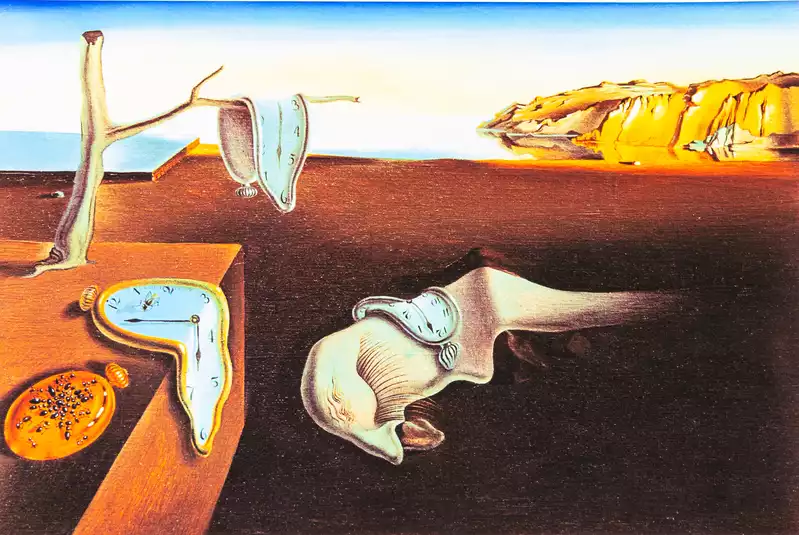
Robert Draws – Salvador Dalí’s iconic painting The Persistence of Memory has captivated art lovers, philosophers, and scholars for decades. The surreal masterpiece, with its melting clocks, stretches the boundaries of reality and challenges our understanding of time. It raises fundamental questions about how time can be perceived and understood. But what is the true meaning behind the piece, and why has it had such a lasting impact on the world of art?
Dalí’s work was deeply influenced by the Surrealist movement, a cultural revolution that sought to express the unconscious mind through unexpected imagery and bizarre juxtapositions. The Persistence of Memory, painted in 1931, is one of Dalí’s most famous surrealist works. It portrays a landscape filled with distorted clocks, draped over trees, furniture, and the terrain itself. The clocks, which seem to be melting or in the process of dissolving, create an eerie sense of time slipping away. This unusual representation of time was revolutionary and still continues to intrigue audiences today.
“Read about: Vibrant Emotions: How Abstract Expressionism Shaped Modern Art”
One of the most fascinating aspects of The Persistence of Memory is the depiction of time through soft, melting clocks. These clocks were likely inspired by Einstein’s theory of relativity, which posits that time is not an absolute, rigid concept but one that is fluid and dependent on the observer’s frame of reference. By distorting time in this way, Dalí was visually demonstrating the relativity of time and its psychological perception.
The soft, distorted clocks in Dalí’s painting appear to be losing their form and structure. This might suggest that time, as we traditionally understand it, is a construct, easily bent and warped by external factors. The clocks’ melted forms reflect a dreamlike quality, reinforcing the idea that time, in the surreal world Dalí created, cannot be strictly measured or contained.
The barren landscape in The Persistence of Memory resembles the coast of Catalonia, Dalí’s home region. This setting contrasts with the soft, organic clocks. The desolation emphasizes a sense of timelessness. There are no bustling cities or ticking clocks. Time appears to have stopped, leaving only decaying symbols behind.
Dalí uses an empty landscape to highlight the fluidity of time. In this scene, time isn’t measured by ticking clocks. Instead, it’s marked by the decay of objects. The barren landscape suggests time is not absolute. It is a more elusive and subjective concept.
“Read more: Embracing Minimalism: Tips for a Simpler Lifestyle”
Another key aspect of The Persistence of Memory is the link between time and memory. The clocks may symbolize how memories warp and shift over time. As the clocks melt, our recollection of events becomes less defined. The contrast between the clock’s rigid structure and its soft, melting form represents time’s scientific concept versus personal experience.
Dalí’s fascination with psychoanalysis also influenced this idea. He was deeply influenced by Sigmund Freud’s work on the unconscious mind. Dalí believed that memory wasn’t a simple recollection; it was active and ever-changing. The fluidity of the clocks represents memory’s instability as it distorts or fades with time.
In The Persistence of Memory, there is also a strange figure lying in the foreground. The figure, which resembles Dalí’s own self-portrait, is both a representation of the artist and a symbol of the human condition. The self-portrait’s presence in the painting invites viewers to reflect on the relationship between the artist, the viewer, and the passage of time. Dalí himself often saw his art as a mirror reflecting his inner world and struggles with identity, time, and existence.
The figure’s presence, along with the melting clocks, challenges the viewer to consider the role of human perception in shaping how we experience time. Just as the clocks are subjective and distorted, so too is the human experience of time. This fusion of the human figure with the surreal landscape invites deeper philosophical questions about existence, memory, and the passage of time.
The Persistence of Memory has influenced countless artists, philosophers, and thinkers since its creation. Dalí’s ability to combine surrealist imagery with deep philosophical inquiry into time and memory has made this painting a timeless work of art. Its continued relevance speaks to its ability to tap into universal themes that resonate with viewers of all ages and backgrounds.
Dalí’s unique approach to representing time as fluid and subjective has also influenced how we view time in our everyday lives. While the painting may have initially seemed like a playful exploration of surrealism, it has evolved into a profound commentary on the relativity of time and the way we experience it.
The Persistence of Memory remains one of the most well-known and beloved works of art in history. Its mysterious imagery, philosophical undertones, and innovative technique continue to captivate and inspire audiences. Dalí’s ability to evoke such powerful emotions and thoughts through simple yet profound symbols, such as the melting clocks, has cemented his place as one of the greatest surrealist artists of all time.
Dalí’s exploration of time in The Persistence of Memory transcends the boundaries of art, philosophy, and science. It challenges us to rethink our assumptions about the world around us and to explore the fluidity of our perceptions. The painting is not just a visual experience; it is an invitation to think deeply about the passage of time and the nature of memory itself.